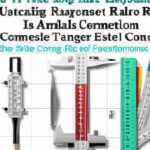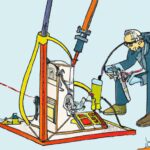Measurement errors are ubiquitous and can adversely affect the accuracy of data collected. Fortunately, there are strategies to minimize such errors. Firstly, ensure the measuring instrument is calibrated correctly, reducing systematic errors. Regular maintenance and verification are imperative. Additionally, using multiple measurements and calculating averages can counteract random errors. Be cautious of human errors caused by perceptual bias or misinterpretation. Training employees in proper measurement techniques can mitigate these errors. Lastly, employ statistical methods, such as regression analysis, to identify and eliminate outliers. By implementing these measures, accurate and reliable measurements can be obtained, leading to improved decision-making and increased confidence in the data collected.
Table of Contents
- Impact of measurement errors
- Importance of accurate measurements.
- Sources of measurement errors
- Strategies to reduce measurement errors
- Types of measurement errors
(Uncertainty & Measurements)
Common measurement errors can significantly impact the accuracy and reliability of data. Here are some frequently encountered errors and effective strategies to minimize them.
One common error is measurement bias, which occurs when the measuring instrument consistently overestimates or underestimates the true value of the variable being measured. To reduce bias, it’s crucial to calibrate instruments regularly, ensuring proper alignment with established standards.
Another error is systematic error caused by factors that consistently influence results in a particular direction. To minimize systematic errors, scientists use control groups and replicate measurements, allowing for comparison and identification of any consistent patterns.
Random error, on the other hand, is unpredictable and can occur due to various factors such as human error or environmental conditions. To reduce random error, multiple measurements should be taken and averaged, increasing the reliability of the overall result.
Instrument error is another common measurement error caused by deficiencies in the measuring instrument itself. Regular maintenance and periodic recalibration of instruments help reduce instrument errors, ensuring accurate measurements.
Procedural error is often a result of human error during the measurement process. To minimize this error, it is vital to follow standardized procedures meticulously, paying close attention to details and minimizing distractions.
Sampling error can occur when the sample selected for measurement does not accurately represent the entire population. To minimize sampling error, random and representative sampling techniques should be employed.
In conclusion, reducing common measurement errors requires a combination of careful calibration, control groups, replication, randomization, proper maintenance of instruments, adherence to standardized procedures, and careful consideration of sample selection. By implementing these strategies, scientists can obtain more accurate and reliable measurements, ensuring the validity of their research findings.
Impact of measurement errors
Measurement errors can have a significant impact on the accuracy and reliability of data gathered through various research methods. These errors can occur due to a range of factors, such as human error, faulty equipment, or environmental conditions. Understanding the impact of measurement errors is crucial for researchers, as it can affect the validity of their findings and the conclusions drawn from them.
One of the key impacts of measurement errors is the potential distortion of data. When errors occur during the measurement process, it can lead to inaccurate readings or observations. For example, if a thermometer is not calibrated properly, it may produce measurements that are consistently higher or lower than the actual temperature. This can result in skewed data and invalidate any conclusions drawn from it.
Measurement errors can also affect the precision and reliability of data. Precision refers to the consistency of measurements, while reliability refers to the repeatability of measurements. When errors occur, they can introduce variability into the data, making it difficult to establish consistent patterns or trends. This can make it challenging to draw reliable conclusions or make accurate predictions based on the data.
In addition, measurement errors can introduce biases into the data. Biases occur when there is a systematic deviation from the true value. For example, if a scale used to measure weight consistently overestimates or underestimates the actual weight, it can lead to biased results. These biases can lead to incorrect interpretations of the data and potentially lead to flawed decisions or actions.
To reduce the impact of measurement errors, researchers can implement various strategies. First, it is crucial to ensure that measurement instruments are calibrated correctly and regularly to maintain accuracy. Additionally, it is vital to train and educate the individuals responsible for taking measurements to minimize human errors. Following standardized procedures and protocols can also help reduce measurement errors and increase the reliability of data.
In conclusion, measurement errors can have a significant impact on research outcomes. They can distort data, affect precision and reliability, and introduce biases. To mitigate these impacts, researchers should focus on calibrating instruments, training individuals, and following standardized procedures. By minimizing measurement errors, researchers can enhance the accuracy and validity of their findings, leading to more reliable conclusions and better-informed decision-making.
Importance of accurate measurements.
Accurate measurements play a crucial role in various fields, including science, engineering, manufacturing, and even everyday activities. They provide the foundation for reliable data analysis, quality control, and decision-making processes. The importance of accurate measurements cannot be overstated, as they directly impact the validity and reliability of the information obtained.
One significant reason for the importance of accurate measurements is their role in ensuring the integrity of scientific research. Precise measurements enable scientists to gather reliable data, leading to accurate conclusions and valid scientific theories. Without accurate measurements, researchers would struggle to gather meaningful information and make sound interpretations.
In engineering and manufacturing, accurate measurements are essential for the development and production of high-quality products. Any miscalculation, no matter how small, can lead to design flaws, production errors, and ultimately, costly consequences. Accurate measurements not only ensure compliance with industry standards but also contribute to the overall safety and performance of the final product.
Accurate measurements are also crucial in everyday activities that people often overlook. For instance, in cooking, precise measurements of ingredients affect the taste, texture, and overall outcome of a recipe. A small deviation from the intended measurements can result in an undesirable or even inedible dish. Similarly, accurate measurements are vital in carpentry, where even a slight error in measurements can result in ill-fitting joints or uneven surfaces.
To reduce measurement errors and improve accuracy, several steps can be taken. First, using appropriate and calibrated measuring tools is essential. Regular calibration ensures the accuracy of the instruments and reduces potential errors. Additionally, proper handling and technique while taking measurements can significantly reduce inaccuracies. This includes minimizing parallax errors, maintaining the correct temperature or pressure conditions for the measurements, and using the appropriate units of measurement.
Training and education also play a significant role in ensuring accurate measurements. By providing individuals with the necessary knowledge and understanding of measurement techniques, they can consistently produce accurate results. This includes understanding the limitations of the measuring instruments, recognizing potential sources of errors, and implementing appropriate control measures.
In conclusion, the importance of accurate measurements cannot be overstated. Whether in scientific research, engineering, manufacturing, or everyday activities, accurate measurements are the foundation for reliable data and informed decision making. Reducing measurement errors through calibration, proper technique, and education is crucial to ensure accuracy and improve outcomes in various fields. Only with accurate measurements can we confidently rely on the information obtained and progress towards success and innovation.
Sources of measurement errors
Sources of measurement errors can arise from various factors, including human error, equipment malfunction, and environmental conditions. Human error is a common source of measurement errors, as individuals may make mistakes during the data collection process. For example, a person may misread a measurement scale or record data inaccurately.
Equipment malfunction is another significant source of measurement errors. Inaccurate or faulty instruments can produce incorrect readings, leading to measurement errors. Calibration issues, sensor drift, or inadequate maintenance can all contribute to equipment malfunctions. It is crucial to regularly check and calibrate measurement devices to minimize these errors.
Environmental conditions can also impact the accuracy of measurements. For instance, variations in temperature, humidity, or pressure can affect the performance of instruments and lead to measurement errors. Additionally, external factors such as electromagnetic interference or vibrations can interfere with the accuracy of measurements.
Sampling errors are another source of measurement errors. When a sample is not representative of the entire population, the measurements obtained may not accurately reflect the true values. Random or systematic errors in the sampling process can occur, affecting the validity of the measurements.
Furthermore, measurement errors can also result from limitations in the measurement technique itself. Some measurement methods inherently have limitations, such as limited precision or sensitivity. It is essential to understand these limitations and consider alternative measurement techniques if necessary.
To reduce measurement errors, several strategies can be employed. First, training and education can help minimize human errors. Providing proper training to individuals involved in data collection can improve accuracy and reduce measurement errors. Additionally, implementing standardized protocols and procedures can help ensure consistency and reduce variability in measurements.
Regular calibration and maintenance of equipment are essential to prevent equipment malfunctions. Routine checks and calibration procedures should be followed to ensure accurate measurements.
Controlling environmental conditions in the measurement process can also help reduce errors. Utilizing appropriate measuring environments and protecting instruments from external interferences can enhance measurement accuracy.
Finally, careful consideration of sample selection and appropriate measurement techniques can help mitigate sampling errors and limitations in the measurement process. By addressing these sources of measurement errors systematically, researchers and practitioners can improve the reliability and validity of their measurements.
In conclusion, sources of measurement errors can arise from human error, equipment malfunction, environmental conditions, sampling errors, and limitations in measurement techniques. Minimizing these errors requires proper training, calibration, maintenance, careful consideration of environmental conditions, and thoughtful sampling and measurement technique selection. By implementing these strategies, measurement errors can be reduced, leading to more accurate and reliable measurements.
Strategies to reduce measurement errors
Measurement errors can occur in various fields, including science, research, and statistics. These errors can lead to inaccurate data, which in turn affects the validity and reliability of the results. However, there are several strategies that can be employed to minimize measurement errors and improve the overall quality of measurements.
One common strategy is to ensure proper calibration of measuring instruments. Regular calibration helps to maintain accuracy and consistency in measurements. This involves comparing the instrument’s readings to a known standard and making necessary adjustments. By calibrating instruments regularly, measurement errors can be minimized, leading to more reliable data.
Another important strategy is to increase sample size. When the sample size is small, measurement errors can have a significant impact on the results. By increasing the sample size, the effect of random errors is reduced, making the measurements more robust and reliable. Larger sample sizes also increase the statistical power of the analysis, allowing for more accurate conclusions to be drawn.
Additionally, conducting multiple measurements can help to reduce errors. By taking multiple readings, both systematic and random errors can be identified and minimized. If consistent measurements are obtained, it increases confidence in the accuracy of the data. In cases where measurements vary, further investigation can be done to identify the sources of error and take corrective actions.
Standardizing measurement procedures is another effective strategy. By establishing clear protocols and guidelines for measurements, consistency can be ensured across different users and settings. This reduces the likelihood of human error and increases the reliability of the measurements. Standardization also allows for easier comparison of results across different studies or experiments.
Regular quality control checks should also be implemented to identify and correct measurement errors. This involves performing routine checks on the equipment, verifying calibration, and ensuring proper handling and storage of measurement devices. These checks can help detect any potential errors or issues before they affect the accuracy of the measurements.
In conclusion, measurement errors can have a significant impact on data quality and reliability. However, by implementing strategies such as instrument calibration, increasing sample sizes, conducting multiple measurements, standardizing procedures, and implementing quality control checks, these errors can be minimized. By adopting these strategies, researchers and practitioners can ensure that their measurements are accurate, reliable, and robust, leading to more meaningful and valid results.
Types of measurement errors
Types of measurement errors can occur in various aspects of data collection. Firstly, random errors are unpredictable variations that can arise due to human or instrument limitations. These errors are irregular and do not follow a distinct pattern. Secondly, systematic errors are consistent variations that occur due to flaws in the measurement process. These errors can be caused by faulty equipment, incorrect calibration, or biased observers. Thirdly, gross errors are significant mistakes that result in extreme values or outliers. Gross errors can occur due to human error, faulty equipment, or improper recording. Fourthly, instrumental errors arise from inaccuracies or faults in the measuring instrument or device. For example, a thermometer that consistently reads temperatures too high or too low will lead to systematic errors. Fifthly, environmental errors are caused by variations in the surrounding conditions during measurement. Changes in temperature, humidity, or lighting can affect the accuracy of measurements. Lastly, personal errors stem from the limitations and biases of the person conducting the measurement. This can include poor technique, misinterpretation of instructions, or subjective judgments. By understanding the different types of measurement errors, researchers can take appropriate steps to minimize their impact on data quality. Methods to reduce measurement errors include conducting repeated measurements to identify and correct any inconsistencies, using calibrated and reliable measuring instruments, training observers to minimize personal errors, and maintaining controlled environmental conditions. Additionally, statistical techniques such as averaging multiple measurements or using error correction formulas can help compensate for random and systematic errors. It is crucial to acknowledge that while measurement errors cannot be completely eliminated, their effects can be minimized through careful planning, rigorous protocols, and continuous quality control measures. By addressing and reducing measurement errors, researchers can improve the accuracy and reliability of their data, leading to more valid and meaningful conclusions.













